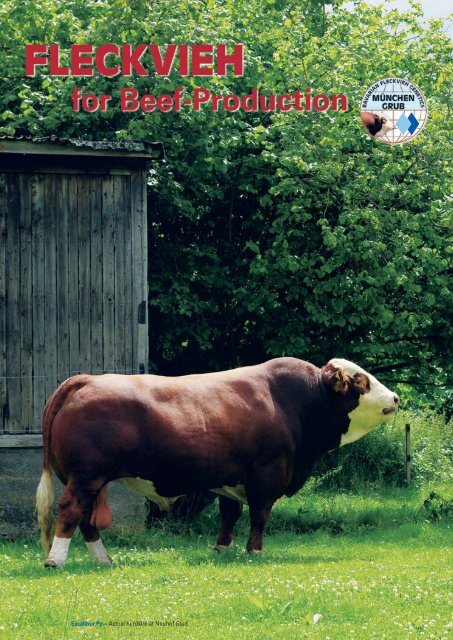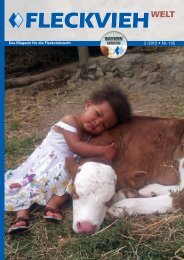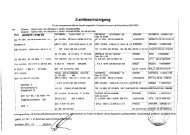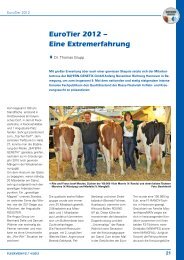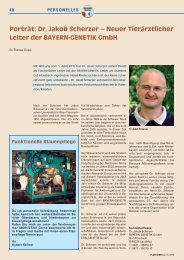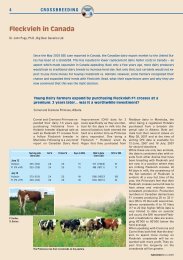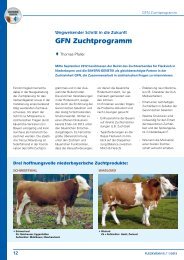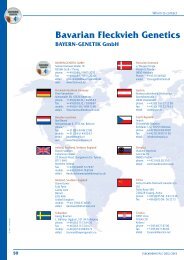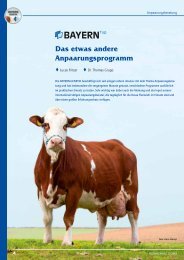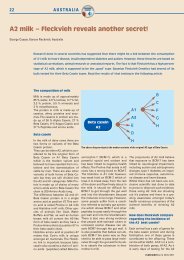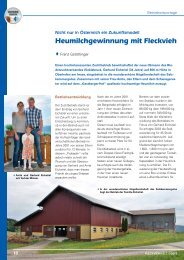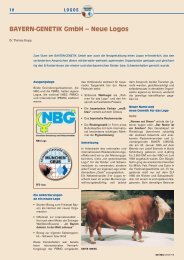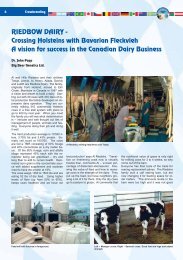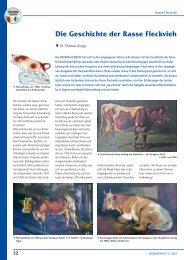Excalibur Pp ? Actual herdsire at Neuhof Stud
Excalibur Pp ? Actual herdsire at Neuhof Stud
Excalibur Pp ? Actual herdsire at Neuhof Stud
Create successful ePaper yourself
Turn your PDF publications into a flip-book with our unique Google optimized e-Paper software.
<strong>Excalibur</strong> <strong>Pp</strong> – <strong>Actual</strong> <strong>herdsire</strong> <strong>at</strong> <strong>Neuhof</strong> <strong>Stud</strong>
24 SOUTHERN AFRICA<br />
Gunzel Kaspar –<br />
Top Fleckvieh genetics from Namibia<br />
Dr. Thomas Grupp, Bavarian Fleckvieh Genetics<br />
The first Fleckvieh breeding c<strong>at</strong>tle arrived in Namibia in the year 1893. They came from Miesbach/Upper<br />
Bavaria to Swakopmund, the only harbour in the former colony „Deutsch-Südwestafrika“. After some<br />
weeks on the sea the animals had to walk all the way up to the future capital Windhoek <strong>at</strong> 1.900 m above<br />
sea level.<br />
Meanwhile the dual purpose breed<br />
Fleckvieh spread to almost all parts<br />
of Namibia and is regarded to be<br />
the best adapted European c<strong>at</strong>tle<br />
breed in this extremely dry and hot<br />
South African country. Namibian<br />
Fleckvieh breeders made an important<br />
contribution to intern<strong>at</strong>ional<br />
Fleckvieh breeding and the success<br />
of Fleckvieh as adaptable beef<br />
breed to a large extend owes to extensive<br />
research done in Namibia<br />
(Om<strong>at</strong>jenne-trial). Meantime the<br />
Simmentaler Fleckvieh breed has<br />
gained even more importance<br />
through the synthetic breed „Simbra“,<br />
a cross between Simmental<br />
Fleckvieh and Brahman. This „new<br />
breed“ has shown a nearly incredible<br />
increase in numbers of breeders<br />
as well as registered animals.<br />
Grootfontein –<br />
The center of agriculture<br />
Grootfontein (Big Fountain), loc<strong>at</strong>ed<br />
450 km north of the capital<br />
Windhoek, is the home of the breeder´s<br />
family Kaspar and Stefanie<br />
Gunzel, who are of German origin.<br />
In the Otavi-Triangle („Corn-Triangle“),<br />
<strong>at</strong> 1.460 m above sea level,<br />
they dedic<strong>at</strong>e their lives to breeding<br />
Simmentaler Fleckvieh and<br />
White Brahman. Besides breeding<br />
in years with enough rainfall also<br />
corn and other crops are grown.<br />
Grootfontein was found by Boer-families,<br />
the so called Dorslandtrekkern<br />
in the year 1885. In the year<br />
1896 the German colonial government<br />
opened up a military base. At<br />
this time the region of Grootfontein<br />
was contamin<strong>at</strong>ed with malaria,<br />
however, the swampland was drained,<br />
the disease was elimin<strong>at</strong>ed<br />
and agriculture got new impulses.<br />
The agricultural potential of the re-<br />
The Gunzel family – breeders from Northern Namibia.<br />
gion of Grootfontein was recognized<br />
quite early, therefore in Rietfontein,<br />
about 35 km to the west, a dairy<br />
was opened up where mainly<br />
cream and butter was produced.<br />
The farmers separ<strong>at</strong>ed the milk on<br />
the farm, delivered the cream to the<br />
dairies and fed the skimmed milk to<br />
their f<strong>at</strong>tening pigs. These sales<br />
provided some extra-income to the<br />
farmers who apart from th<strong>at</strong> only<br />
had the returns from selling their<br />
f<strong>at</strong>tening c<strong>at</strong>tle once a year. A very<br />
far sighted farmer and the founder<br />
of the dairy, August Stauch, who<br />
gained some wealth through diamond<br />
finds aimed to develop the<br />
whole country through this additional<br />
milk income. The world wars<br />
put a sudden end to these plans.<br />
However, the dairy earned good<br />
profits till the 70ties of the 20th century.<br />
The raising uncertainty of rainfall<br />
and the increasing difficulties<br />
for dairy farmers led to the cess<strong>at</strong>ion<br />
of the business some years<br />
ago.<br />
Gunzel Simmentaler<br />
Tobias Gunzel, the grandf<strong>at</strong>her of<br />
the actual owner, was carpenter by<br />
trade. He was born in Saxony close<br />
to Chemnitz where he run his own<br />
construction company. In the year<br />
1926 he emigr<strong>at</strong>ed to South-West-<br />
Africa and worked for different farmers<br />
as farm manager.<br />
In 1940 he bought the Bornholm<br />
farm which is 4671 ha in size, about<br />
66 km south of Grootfontein. Tobias<br />
Gunzel used his position as farm<br />
manager to build up his own c<strong>at</strong>tle<br />
herd which <strong>at</strong> th<strong>at</strong> time consisted of<br />
Fleckvieh crossbreds. To increase<br />
the Simmentaler Fleckvieh blood<br />
he bought bulls from the pioneer<br />
farms Voigtland (Voigts family) and<br />
Lichtenstein (Rusch family). When<br />
he moved to Bornholm he still worked<br />
as a constructor in the surroundings<br />
of Grootfontein, the farm was<br />
managed by his wife Liselotte. All<br />
cows were kept extensively without<br />
any concentr<strong>at</strong>e but were milked<br />
FLECKVIEHWorld 2009/2010
for cream production in Rietfontein.<br />
The cream was brought to the farm<br />
building on ox wagons and l<strong>at</strong>er<br />
delivered by car to the dairy 1 or 2<br />
times a day. From the skimmed<br />
milk the Gunzels produced casein<br />
which they fed to their 50 pigs. The<br />
Foot-and-Mouth disease put an end<br />
to the cream sales which resulted in<br />
a breakdown of the whole cream<br />
production. The Gunzel Simmentaler<br />
stud continued with beef production.<br />
At Bornholm the average rainfall is<br />
quite low (200 - 350 mm) so only<br />
grazing is possible. In 1995 Helmi<br />
Gunzel bought a farm in a good<br />
area close to Grootfontein with higher<br />
rainfall (up to 700 mm) to produce<br />
maize, sunflowers and other<br />
crops for human consumption.<br />
During the 70ties the first three<br />
breeding c<strong>at</strong>tle were imported from<br />
Germany. By th<strong>at</strong> time Helmi Gunzel<br />
had taken over the farm from<br />
his f<strong>at</strong>her Tobias. Some years l<strong>at</strong>er<br />
he bought some animals in Europe<br />
again and brought them to Namibia,<br />
<strong>at</strong> first the sire Graf, a Graberson<br />
and in the year 1988 four female<br />
animals and the sire Haribo.<br />
These animals were imported with<br />
the aim to improve milk production<br />
and udder quality.<br />
From the year 1990 on, Helmi and<br />
his son Kaspar did the breeding<br />
work together, till Kaspar took over<br />
the farm in 2005 after the sudden<br />
de<strong>at</strong>h of his f<strong>at</strong>her. Helmi Gunzel<br />
came to Germany almost every year<br />
and visited Bavarian Fleckvieh<br />
Genetics in Munich. Thus he was always<br />
excellently informed about<br />
Fleckvieh breeding in Bavaria and<br />
used horned and polled sires from<br />
Bavarian Fleckvieh Genetics in his<br />
herd. Helmi and Kaspar always were<br />
very critical and it sometimes<br />
took a long time to convince them<br />
of a sire. Zimbo and Eisenherz did<br />
very well on their farm. <strong>Actual</strong>ly<br />
mainly bulls from South Africa and<br />
own bulls are used in the herd.<br />
A milestone in their breeding work<br />
was the purchase of cow-calf pair<br />
Wisp-Will-P<strong>at</strong>ty with heifer calf Pam<br />
(S: Henkel, a Haxl-son) in 1992 from<br />
the famous South African breeders<br />
Willy and Llewellyn Angus. This<br />
cow impressed the Namibians<br />
especially with her soundness and<br />
faultless type traits. Wisp-Will P<strong>at</strong>ty<br />
<strong>at</strong> th<strong>at</strong> time was due to Wisp-Will-<br />
Mandrake, out of this m<strong>at</strong>ing Gunzel<br />
P<strong>at</strong>ty was born. The Gunzels were<br />
the first to use embryotransfer in<br />
FLECKVIEHWorld 2009/2010<br />
Wisp-Will-P<strong>at</strong>ty, dam of Wisp-Will Pam.<br />
Wisp-Will Pam, dam of Gunzel P<strong>at</strong>ty and Gunzel Kaspar.<br />
Gunzel P<strong>at</strong>ty, daughter of Wisp-Will Pam.<br />
SOUTHERN AFRICA 25
26 SOUTHERN AFRICA<br />
Kaiser was imported directly from Germany.<br />
Namibia on their farm in the same<br />
year when they bought P<strong>at</strong>ty and<br />
Pam.<br />
The cow Wisp-Will Pam was one of<br />
the most famous breeding cows of<br />
Southern Africa. Already <strong>at</strong> an age<br />
of 2,5 years she was awarded<br />
champion of the Windhoek Show<br />
and in the following years she remained<br />
unbe<strong>at</strong>en.<br />
On the occasion of the World Simmental<br />
Fleckvieh Congress in the<br />
year 1996 the Intern<strong>at</strong>ional Championships<br />
took place in Pretoria.<br />
The Gunzel family drove over<br />
2000 km with several breeding c<strong>at</strong>-<br />
Original German pedigree of Kaiser.<br />
tle in order to take part in this unique<br />
event, an incredible stress for<br />
the family and their c<strong>at</strong>tle. The cow<br />
Wisp-Will Pam won the senior- udder<br />
class, also junior-class honors<br />
went to a cow out of the barn of the<br />
Gunzels, though she was out of a<br />
different bloodline. Wisp-Will Pam<br />
took part in the final round for the<br />
selection of the champion cow. An<br />
indisposition she contracted on the<br />
way to the show detained her from<br />
a victory. The author of this article<br />
was completely fascin<strong>at</strong>ed from the<br />
femaleness, type traits and soundness<br />
of this cow. In his opinion she<br />
was the best breeding cow he had<br />
ever seen in Southern Africa. The<br />
Pretoria Show 1996 was a very special<br />
show in Fleckvieh history, since<br />
never before more Fleckvieh c<strong>at</strong>tle<br />
have been exhibited <strong>at</strong> the same time<br />
than <strong>at</strong> this World Congress and<br />
therefore competition was very<br />
strong.<br />
The Gunzels also took part in the<br />
Intern<strong>at</strong>ional Championships in<br />
Pretoria in the year 2000, where<br />
they celebr<strong>at</strong>ed considerable success<br />
in a hard competition. The sire<br />
Gunzel Uranus was awarded champion<br />
sire over all.<br />
In the year 2002 the World Congress<br />
was hold in South Africa / Namibia<br />
already for the third time.<br />
Once again the Intern<strong>at</strong>ional Championships<br />
took place in Pretoria on<br />
the occasion of the World Congress.<br />
At this show the P<strong>at</strong>ty-family<br />
celebr<strong>at</strong>ed gre<strong>at</strong> success – P<strong>at</strong>tys<br />
son Gunzel Mocca was Reserve<br />
Grand Champion in a first-class<br />
competition with excellent sires.<br />
The P<strong>at</strong>ty-daughter „Petina“ won<br />
the udder class and completed the<br />
breeding success for Namibia.<br />
In the year 2006 Gunzel „Giola”, a<br />
granddaughter of Pam, was overall<br />
champion of the Windhoek Show<br />
and won the newly invented award<br />
„Champion of the Champions of All<br />
Breeds”. Doubtless it is unique th<strong>at</strong><br />
FLECKVIEHWorld 2009/2010
Kykso Kaim<strong>at</strong>, one of the few progeny of Kaiser continued the K<strong>at</strong>er-Line <strong>at</strong> Kysko Simmentalers.<br />
the cows Pam, P<strong>at</strong>ty and their progeny<br />
won the award for the best dual<br />
purpose cow <strong>at</strong> the Windhoek<br />
Show 7 years in a row.<br />
In 1992 Kaspar Gunzel started a<br />
new branch on the farm, the breeding<br />
of Brahman. Kaspar wanted to<br />
put his breeding ambitions to good<br />
use in his own herd. Furthermore<br />
this breed is ideally suited for<br />
crossbreeding with Simmentaler<br />
Fleckvieh. Thus the demands of<br />
those buyers could be met who<br />
looked for Simmentaler Fleckvieh<br />
and Brahman sires. Also, with<br />
Brahman the Gunzels are very successful.<br />
The highlight was the year<br />
2008, when all awards went to this<br />
farm and the most expensive Brahman<br />
sire of Namibia was sold for<br />
N$ 170 000.00.<br />
The Gunzel Simmentaler stud has<br />
112 registered cows, the Makalani<br />
Brahman stud has 92 cows th<strong>at</strong> are<br />
registered in the herdbook. Every<br />
year about 20 to 25 bulls of each<br />
breed are marketed on auctions,<br />
c<strong>at</strong>tle shows or directly from the<br />
farm. All bulls are tested for semen<br />
quality, reproductive diseases, tenderness<br />
and marbling and feed conversion.<br />
All Simmentaler Fleckvieh<br />
c<strong>at</strong>tle are judged annually by an inspector<br />
from the Breed Society.<br />
Gunzel Kaspar –<br />
excellent combin<strong>at</strong>ion<br />
of bloodlines<br />
Strikingly on the Gunzel farm all<br />
cows from the P-line breed excellently,<br />
regardless of the m<strong>at</strong>ing, a<br />
fact th<strong>at</strong> can be often seen in dominant<br />
cow families. The male animals<br />
all showed an excellent muscling,<br />
the female animals captiv<strong>at</strong>ed<br />
FLECKVIEHWorld 2009/2010<br />
through their type traits, soundness<br />
and good udders. 40 % of today’s<br />
breeding c<strong>at</strong>tle on the Gunzel farm<br />
descend from this cow family. The<br />
cows Wisp-Will Pam and Gunzel<br />
P<strong>at</strong>ty were used for embryo production<br />
and some of the resulting embryos<br />
were exported to Canada,<br />
Brazil and Australia.<br />
Today the breeding focus is set on<br />
the selling of hard, adapted and<br />
good muscled sires with excellent<br />
breeding values th<strong>at</strong> are now available<br />
after the introduction of the<br />
Australian Breedplan-System in<br />
Southern Africa. All animals are tested<br />
for their back muscling with<br />
ultrasound and gene tests are done<br />
for feed efficiency, feed intake,<br />
marbling and tenderness. In addition<br />
to all these measures an animal<br />
has to be structurally sound, which<br />
means th<strong>at</strong> appearance as well as<br />
the figures have to make a good impression.<br />
The goal is to breed c<strong>at</strong>tle<br />
th<strong>at</strong> meet the demands of efficient<br />
and productive beef animals with<br />
Gunzel Kaspar was bought by Bavarian Fleckvieh Genetics.<br />
SOUTHERN AFRICA 27<br />
excellent m<strong>at</strong>ernal characteristics<br />
th<strong>at</strong> can cope with the poor feed in<br />
Namibia.<br />
Bavarian Fleckvieh Genetics bought<br />
genetics from Namibia already some<br />
years ago: Hauk Erz, a polled Eisenherz-son,<br />
who has excellent progeny<br />
in Southern Africa.<br />
The combin<strong>at</strong>ion of Kykso-blood via<br />
the sire Kykso Kaino with the P-family<br />
on the Gunzel farm fully represents<br />
our idea of a combin<strong>at</strong>ion of<br />
the best genes. The K<strong>at</strong>er line th<strong>at</strong><br />
already is extinct in Germany on the<br />
f<strong>at</strong>her side, was used a lot on the<br />
Swart farm, and thus K<strong>at</strong>er-blood is<br />
very often found in Kykso farm pedigrees.<br />
For example the mother of<br />
Kaino has two ancestors with K<strong>at</strong>erblood<br />
in her pedigree. The K<strong>at</strong>er line<br />
has proven to be very adaptable to<br />
Southern African conditions and<br />
many other countries. It is always<br />
interesting to follow up the p<strong>at</strong>hs of<br />
breeding c<strong>at</strong>tle th<strong>at</strong> have been exported<br />
from Germany in the mid<br />
70ties with the help of the Fleckvieh<br />
expert Peter Massmann. The sire<br />
Kaiser unfortun<strong>at</strong>ely had only very<br />
few calves, amongst those Kaim<strong>at</strong>,<br />
who continued the line.<br />
After the auction <strong>at</strong> Windhoek Gunzel<br />
Kaspar was brought to a quarantine<br />
st<strong>at</strong>ion <strong>at</strong> the Western Cape,<br />
where he produced semen for export<br />
purposes, for embryotransfer<br />
and for the use in Southern Africa.<br />
Gunzel Kaspar completes the list of<br />
hard and adaptable Fleckvieh genetics<br />
of Bavarian Fleckvieh Genetics<br />
th<strong>at</strong> proves its advantages and potential<br />
especially in hot, dry and<br />
subtropical conditions. We also are<br />
always interested in testing South<br />
African genetics in Germany for its<br />
actual milk- and beef production<br />
and its type traits.


